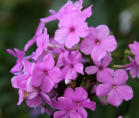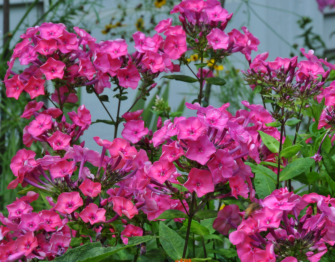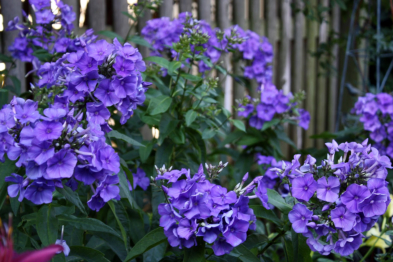




Count on tall garden phlox (Phlox paniculata hybrids) to provide a colourful summer display in perennial gardens, blooming as much as six
weeks or more. Some cultivars begin blooming in mid-summer; others not until late August
Garden phlox are available in a wide range of pink, rose, red, lavender, purple, and white, along with bi-colours that have an "eye"
in the centre of each flower or a contrasting margin.
Tall garden phlox grow best in full sunlight, but will tolerate light shade.
Phlox in bloom are a sight to behold, with masses of small, star-shaped, colorful flowers blanketing the plants.
They come in a range of heights from two to five feet, and produce huge billows of bloom in mid-late summer, in a range of colors
from pure white to red, with nearly every shade of pink, lavender, salmon and purple in between. They grow happily in most parts
of the country and, properly planted and sited, they are largely pest and disease free, and provide decades of bloom - the perfect
perennial!
Phlox Culture
Phlox prosper in a cool sunny climate, well-watered, in rich sweet soil. In much of the country, they will thrive in full sun, although
partial shade is fine, as long as the plants receive at least 6 hours of direct sun. In hot climates partial shade is recommended.
The soil should be rich and slightly sweet (alkaline), so if your soil tends towards the acidic side, regular applications of lime is
recommended, say every two or three years. The plants should be set in quite rich soil, enriched with compost or aged manure.
This type of soil will also hold water well, an important feature, for phlox do not do well in hot dry soils. Mulching will assist in
water conservation and in keeping the soil cool. Because they are heavy feeders, even beautifully prepared soil will decline after
four or five years, and it is best to plan on resetting your plants on a regular basis, every four or five years.
Pests
Phlox have very few insect pests. The only pest that is commonly seen is spider mite, which congregates on the underside of
leaves, causing leaves to curl, dry up and fall off. You can detect this in the early stages, by observing a slight dusty sootiness on
the undersides. They appear to be a problem only when the situation is too hot and dry, and so again it is remedied by improving
the soil and increasing the watering. For an immediate response, a good blast of water on the leaves is helpful.
Above All, Keep your Phlox in Cool and Well-watered Soils
Phlox like to be in cool location, preferably in a little shade, and in a humus-rich soil. Did you know that their native situation is
woodland, not out on the dry open contryside If planted in full sun, have other plants grow about the bases, to keep the soils
shaded. By all means water them when the weather is dry. The plants should be lifted out every five years or so, and reset in
newly and heavily enriched soil (compost or aged manure). Phlox detest hot and dry soils.
Powdery Mildew - Control Powdery Mildew with Proper Culture
Many people find their plants are troubled with powdery mildew, a white fungus that bespeckles or coats the leaves, typically in
high summer. Although it is never fatal, it can be unsightly, and may lessen flowering and lead to leaf drop.
Treatment for Powdery Mildew
There may be times or locations where you need to do more. If you must spray, horticultural oil works well as a preventative.
Spray every two weeks with a light summer oil, which protects the leaves, and doesn’t wash off easily in the rain. Plus, it makes
the leaves nice and shiny.
Plox are sold in 3ltr and 5ltr pots
PHLOX




Scientific Name :
Phlox Paniculata
Common Name :
Garden Phlox
Blooming Season :
Spring, Summer
Plant Habit :
Upright
Water :
Medium
Position :
Sun
Height :
12-36 inches
Alcea (Hollyhock)
Aquilegia
Buddliea
Buddliea Altternifolia
Delphinium
Dianthus (Carnations)
Echinacea
Eryngium
Geranium
Gerbera
Geum
Gypsophila
Herbs
Hosta
Iris
Kniphofia
Lantana
Leucanthemum
Lupins
Monarda
Penstemon
Peony
Phlox
Rudbeckia
Sidalcea
Sysirinchium
Tanacetum (Pyrethrum)
Thalictrum
Trollius
Verbena
About Us
Where To Find Us
Contact Us
Alton
Aresford
Burley
Cosham
Ellingham & Ringwood
Emsworth
Odiham
Petersfield
Ringwood
Southampton
Southsea
Winchester
Phlox Purple Flame
Phlox Lilac Flame
Phlox Red Flame
Phlox Jeffs Pink
Phlox Tiara









Phlox Orange Perfection






